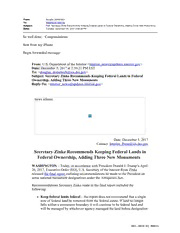
2019 01 Release Set 1 Doc 43 PDF
Preview 2019 01 Release Set 1 Doc 43
From: Douglas Domenech To: Magallanes Downey Subject: Fwd: Secretary Zinke Recommends Keeping Federal Lands in Federal Ownership, Adding Three New Monuments Date: Tuesday, December 05, 2017 3:08:06 PM So well done. Congratulations. Sent from my iPhone Begin forwarded message: From: U.S. Department of the Interior <[email protected]> Date: December 5, 2017 at 2:50:21 PM EST To: <[email protected]> Subject: Secretary Zinke Recommends Keeping Federal Lands in Federal Ownership, Adding Three New Monuments Reply-To: <[email protected]> news release Date: December 5, 2017 Contact: [email protected] Secretary Zinke Recommends Keeping Federal Lands in Federal Ownership, Adding Three New Monuments WASHINGTON – Today, in accordance with President Donald J. Trump’s April 26, 2017, Executive Order (EO), U.S. Secretary of the Interior Ryan Zinke released the final report outlining recommendations he made to the President on some national monument designations under the Antiquities Act. Recommendations Secretary Zinke made in the final report included the following: Keep federal lands federal - the report does not recommend that a single acre of federal land be removed from the federal estate. If land no longer falls within a monument boundary it will continue to be federal land and will be managed by whichever agency managed the land before designation DOI-2019-01 00421 Add three new national monuments - Secretary Zinke recommended beginning a process to consider three new national monuments: The Badger II Medicine Area (Montana), Camp Nelson (Kentucky), and the Medgar Evers Home (Mississippi). Modify the boundaries and management of four monuments - Bears Ears, Grand Staircase, Cascade-Siskiyou, and Gold Butte National Monuments Expand access for hunting and fishing - Maintain an ongoing review to ensure public access to encourage more hunting and fishing in monuments “America has spoken and public land belongs to the people,” said Secretary Zinke. “As I visited the Monuments across this country, I met with Americans on all sides of the issue -- from ranchers to conservationists to tribal leaders -- and found that we agree on wanting to protect our heritage while still allowing public access to public land. My recommendations to the President reflect that, in some circumstances, proclamations should be amended, boundaries revised, and management plans updated.” FACT VS FICTION: Antiquities Act and Monument Review Myth: No president has shrunk a monument. False: Monuments have been reduced at least eighteen times under presidents on both sides of the aisle. Some examples include President John F. Kennedy excluding Bandelier National Monument, Presidents Taft, Wilson, and Coolidge reducing Mount Olympus National Monument, and President Eisenhower reducing the Great Sand Dunes National Monument in Colorado. Myth: The monument review will sell/transfer public lands to states. False: This is not true. The Secretary adamantly opposes the wholesale sale or transfer of public lands. The Antiquities Act only allows federal land to be reserved as a national monument. Therefore, if any monument is reduced, the land would remain federally owned and would be managed by the appropriate federal land management agency, such as the BLM, U.S. Forest Service, U.S. Fish and Wildlife Service, or the National Park Service (NPS). Myth: Removing the monument designation from land will leave Native American artifacts and paleontological objects subject to looting or desecration. False: This is not true. Whether these resources are found on land designated as a monument, national forest, BLM- managed public land, or other federal land, it is generally illegal to remove or disrupt these resources without a permit issued by the federal government. Myth: The monument review will close/sell/transfer national parks. False: No national parks are under review. Myth: The review was done without meeting advocates for national monuments. False: The Secretary visited eight monuments in six states and personally hosted more than 60 meetings attended by hundreds of local stakeholders. Attendees included individuals and organizations representing all sides of the debate ranging DOI-2019-01 00422
